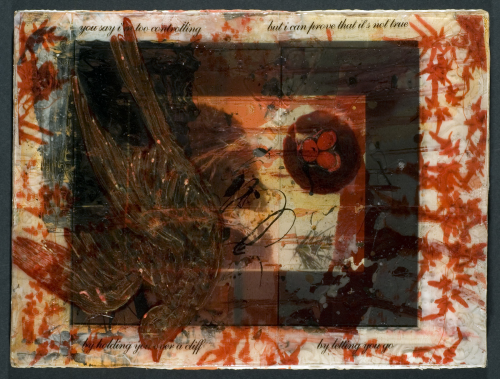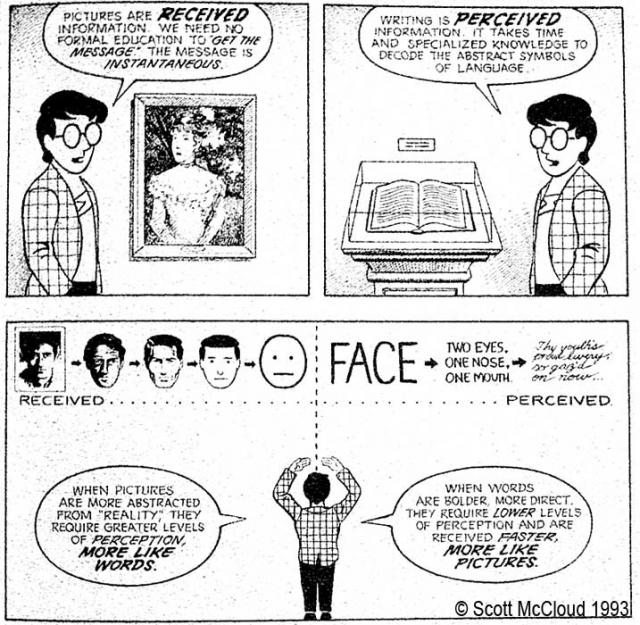Serendip is an independent site partnering with faculty at multiple colleges and universities around the world. Happy exploring!
Notes Towards Day 16 (Th, Mar. 15): Dreaming Us


Kim Nortrop, "A Game of You," from
The Dream Suite, inspired by The Sandman
[genre comparison??]
I. coursekeeping
Tuesday: continue discussing A Game of You,
linking together our discussions of literary
genres and the genre that is the evolving self....
but first! no responses (yet) from English or Ed dept members
re: "our" idea of an English lab, but a great nudging response
from someone in Biology: Loopy Inquiry: Science and Humanities-->
what is the difference between a lab, an experiment, research
and the scientific method....At each step there is the loop of
observation and story-telling...[but] a lab in a classroom is only
very, very remotely related to actual hypothesis driven science...
with a link to Reclaiming the Imagination: A reality-directed faculty
of imagination has clear survival value….We have to work out
what to do by thinking through the possibilities in ways that are
… not less imaginative when more realistic. Knowledge, far from
limiting imagination, enables it to serve its central function….
Imagination plays a vital role in justifying ideas as well as generating
them in the first place.
also, not unrelatedly: Encyclopaedia Britannica Stops the Presses
"we need to have an alternative where facts really matter. Britannica
won’t be able to be as large, but it will always be factually correct.”
But one widely publicized study, published in 2005 by Nature, called
into question Britannica’s presumed accuracy advantage over Wikipedia.
The study said that out of 42 competing entries, Wikipedia made an
average of four errors in each article, and Britannica three. Britannica
responded with a lengthy rebuttal saying the study was error-laden
and “completely without merit.”
II. A Game of You: is this the "same" genre as
the one Satrapi produced in Persepolis? What
might be useful to us, in thinking of them as
occupying the same category?
Share first our perceptions of/initial questions
about Gaiman's graphic narrative....
(following dglasser's queries:
"Does the medium determine how you perceive an image?
Do different mediums change how you think?")
What was your EXPERIENCE of encountering the text?
How did it "operate" on you?
What did you LEARN--and howcan you THEORIZE about
that experience--and its relevance to our conversations here?
Cf. to Persepolis....? generically, or in terms of the evolving genre of the self??
II. Particularly striking intervention in the binary we constructed
for the remainder of the semester, shifting from "non-fiction"
to "speculative fiction," from "realistic" stories to "science fiction" -->
the non-graphic geneology of Gaiman's graphic novel:
it opens w/ a quote from Alice in Wonderland,
and a wonderful introduction by Samuel Delaney,
which describes the "two worlds" of the narrative,
one represented by words, one represented by pictures
... and elements from each will constantly impinge,
cross over, to shock and distort what goes on in the other....
"There is no solid status quo, only a series of relative realities...
any and all of which are frail, and subject to eruptions
from other states and conditions..."
[fantasy/dominant ideology/irony....]
The Game of you is...not the Game of I....in the rich, complex,
and socially constructed world around us, you cannot be what--
or who--you want to be without some support from me..."
III. Some (other) critical commentary, perhaps useful....?
Derek Parker Royal "Introduction: Coloring America; Multi-Ethnic
Engagement with Graphic Narrative." MELUS 32, 3 (Fall 2007): 7-22.
visual language: more immediate processing time and more
"efficient exchange between author(s) and audience
heavily coded medium, rely on stereotyping
broader, more abstract a figure: closer we come to identifying with it
time is spacialized in graphic narrative
comics' spatio-topical system foregrounds relational perspective:
word balloons, frame of individual panels, gutter ("blank" space between panels),
strip (horizontal ban of panel arrangement), page layout
graphic narrative best term to capture most permutations of comics
Annalisa Castaldo "No More Yielding than a Dream,"
College Literature 31, 4 (Fall 2004): 94-100.
equal weight to text and images, providing both
immediate effect and intellectual engagement
because drawn: illustrate the fantastic and unreal more effectively
leads to persistent metatextuality, as characters
regularly cross over into other universes
continuing series, which allows for slow unfolding of ideas
"For Gaiman, dreams (both sleeping dreams and waking wishes)
are both the shadow and seed of reality."
Richard Walsh, "The Narrative Imagination Across Media."
Modern Fictions Studies 52, 4 (2006): 855-868.
Narrative cannot be medium-independent: it is always dependent
on representation in some medium.
dreaming is a "first draft of thought"..."the dream can't revise"...
is a sequential, recursive process...
can be understood as ... the proto-fiction
or as the proto-reality?
"Shouldn't stories dictate the shape our comics take, and not the other way around?
...a new form of sequential art...that recaptures comics' pre-print ancestor..."
thinking about graphic narratives as contemporary forms of medieval illuminated manuscripts??


